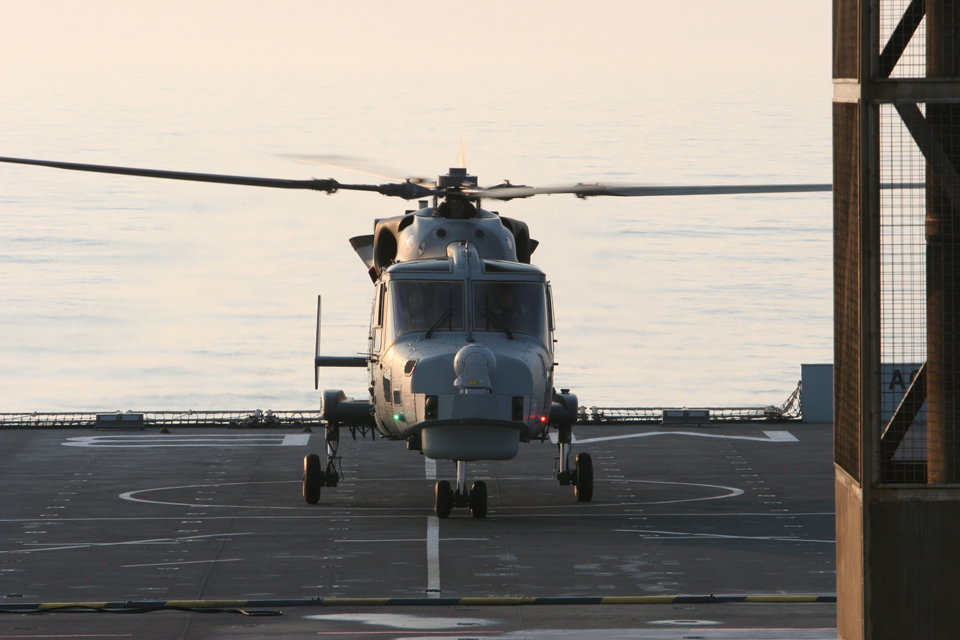First Navy aircrew begin training on Wildcat
The Royal Navy has begun training the first aircrew to fly its next-generation helicopter, the Wildcat.
![A Royal Navy Wildcat helicopter carries out deck landings on RFA Mounts Bay [Picture: Crown copyright]](https://assets.publishing.service.gov.uk/media/5a60fa52ed915d7dfea6a338/s300_20130610_Wildcat_MTSB_1.jpg)
A Royal Navy Wildcat helicopter carries out deck landings on RFA Mounts Bay
Five Fleet Air Arm pilots and observers are currently undergoing conversion training at the new Wildcat Training Centre at Royal Naval Air Station (RNAS) Yeovilton, with the helicopter – successor to the Lynx – just 18 months away from front line service.
From the beginning of 2015, Wildcats will begin to relieve the Lynx as the mainstay of helicopter operations for all of the Royal Navy’s Type 45 destroyers and some of its Type 23 frigates, as well as any other air missions the fleet requires of it.
700W – ‘W’ for Wildcat – Naval Air Squadron (700W NAS), based at RNAS Yeovilton in Somerset, got its first naval version of the new helicopter on 1 May 2013.
The squadron has been formed especially to bring Wildcat into front line service – squeezing every last ounce of information out of the helicopter so they can share it with the rest of the Wildcat world.

Royal Navy Wildcat helicopter (library image) [Picture: Copyright AgustaWestland]
Last month 700W NAS took the naval Wildcat to sea for the first time, carrying out deck landings on Royal Fleet Auxiliary vessel Mounts Bay off the south coast off England.
Its personnel – 5 pilots, 6 observers (who act as navigators/weapons systems specialists) and 44 ground crew and technicians – are also developing the tactics which will allow Wildcat to track drug-runners, intercept pirates, take out small surface targets, sink submarines and save lives in mid-ocean rescues; basically everything its predecessor Lynx does, only better.
Wildcat pilot Lieutenant James Woods said:
We often hear ‘it looks like a Lynx, how different can it be?’ Well yes, from the outside it bears a striking resemblance to the Lynx, but that really is where the similarity ends.
In Wildcat the Fleet Air Arm is getting a world-leading naval helicopter that builds upon the successes of the present-day Lynx. It’s bristling with the latest advanced mission systems and weapons – it’s the perfect solution to allow the Royal Navy to meet the challenges of tomorrow.

A Royal Navy Wildcat helicopter on RFA Mounts Bay's flight deck [Picture: Crown copyright]
The 700W NAS Wildcat pioneers were taught to fly the new helicopter by its builders, AgustaWestland.
Now they’re passing on that experience to existing trained aircrew. And, from early 2015, the Fleet Air Arm will take rookie fliers straight from ‘helicopter school’ at RAF Shawbury and turn them into Wildcat pilots and crew.
Wildcat was on public display at RAF Waddington last weekend, and will be present at 4 more air shows across the UK this summer:
-
RNAS Yeovilton Air Day 2013 on Saturday 13 July
-
The Royal International Air Tattoo at RAF Fairford on 20 to 21 July
-
RNAS Culdrose Air Day 2013 on Wednesday 24 July
-
Wings & Wheels at Dunsfold over the August Bank Holiday weekend

Royal Navy Wildcat helicopter (library image) [Picture: Copyright AgustaWestland]
In the autumn the rest of the Navy will get to see what Wildcat can do when the helicopter takes part in the Joint Warrior war games off Scotland for the first time.
The Fleet Air Arm is buying 28 Wildcats and the Army Air Corps is receiving 34. The maritime variant will be fitted with the SELEX Galileo Seaspray 7000E active electronically scanned array radar system for maritime surveillance missions. All will be based at Yeovilton.
The last Lynx will be withdrawn from service in the spring of 2017.